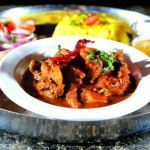- Got your goat: Though goat cheese is popular in the United States, goat meat has lagged behind, but it’s becoming more popular, especially in dishes like goat vindaloo (pictured). Photo by Bill Rhodes
- Bily goat in the rough: Goats get a reputation for eating everything because they forage rather than graze. Here, they munch on multiflora rose. Photo by Hank Fusel
Goats have an undeserved bad reputation. They’re charged with eating absolutely everything and smelling fiercely bad while doing it, like a teenage boy, but with more facial hair. At least in our beef- and chicken-centric corner of the world, the bearded ruminant's rather lowly status has kept its meat off the mainstream menu, but times are changing. Goat, already one of the the most widely consumed meats on the planet, is a staple of many types of cuisine — Caribbean, Indian and South American — and it’s poised to make a cloven-hoofed entrance on a menu near you.
Though Kentucky Fried Goat is probably a long way off in the minds of the general public, some American eaters are coming around, especially with the prevalence of Latino fare and the increasing consumption of other international foods. With a dining public that's increasingly concerned about health and quality (and more likely to think outside of the takeout box), goat meat is becoming more of a viable protein solution. Per ounce, goat packs more of a protein punch than beef, while taking less land and fewer resources to raise (goats are accomplished foragers). And goat is, incredibly, lower in fat than chicken.
Berries and meat
Walter Harrill of Imladris Farms raises goats on what was once his great-grandfather's land. The property, abandoned for more than two decades, was choked with bittersweet, blackberry brambles and tangles of other thorny flora by the time Harrill and his wife got their hands on it.
Now, Imladris is a thriving berry farm, well-known for its spectacular jams, which can often be found on the tables of locally focused restaurants like Early Girl Eatery, Over Easy Cafe and HomeGrown. Harrill also raises goats and rabbits on his property. Originally, Harrill brought goats to the farm with the intention of starting a creamery. That idea fizzled out before it ever started, owing to tight regulations for small dairies in North Carolina in the ‘90s.
“Two things came from that,” Harrill says. “No. 1 was, we would do our research before we charged forward,” he laughs. “No. 2 was that we had these goats, so what were we going to do with them?”
At first, the Harrills harvested a few goats per year for personal consumption, selling off a few here and there. Only in the past two years has Imladris Farms been able to consider goat as a potentially profitable business. “I've been sitting in the background quietly, waiting for the market to open up,” Harrill says. “In 2000, the market for goat meat in Western North Carolina was generally transient immigrants, mostly farm labor.” Most of his customers, he says, could pay about $25 a head for each goat, so they would harvest the goats live and do the dirty work themselves. “There's no profit in that,” says Harrill.
But last year, the farm sold 20 animals, mostly in retail cuts. “At this point, we're stretching to have any meat available for wholesale.”
Got goat?
One of Imladris Farms' wholesale customers is Meherwan Irani, chef of Chai Pani, an Indian restaurant on Battery Park Avenue in Asheville.
Irani already makes curries and kebabs with Harrill's goats. Although the meat isn't on the regular menu, it appears as a special. “A couple of weeks ago we featured goat vindaloo, a popular Goan-Portuguese curry that's vinegary and fiery hot, typically made with pork or goat,” says Irani. The Portuguese colonized Goa, a province of India, and brought with them a taste for pork, vinegar and chilies, he says.
People have loved the goat meat, he says. So positive is the feedback that the restaurant will begin to receive whole goat, to be butchered in-house — and every part will be used. Irani plans to feature a dish of masala livers with caramelized onion and various stews and curries made with the leg and shoulder, seekh kebabs (ground goat with some lamb added for fat content with spices, mint, chilies, then grilled on skewers) and tandoori chops. “We'll also probably braise the neck and do some North Carolina-meets-India pulled-goat barbecue, and make stock with the bones,” he says.
“Walter's goat meat is perfect,” Irani says. “It's not any gamier than lamb — I actually found it milder.” Goat meat, Irani says, is very lean, so it needs extra babying and braising time, particularly with hardworking muscles like shoulder and leg. “But it's absolutely worth it,” he says. “I never ate lamb or beef growing up in India — it was goat.”
The Blackbird in Black Mountain is getting in on the goat game, too. The self-described new-American tavern recently highlighted local goat at one of its oft-held farm dinners. Half of the offerings featured Looking Glass goat cheese (a salad, cheesecake, cheese board) and the other half featured meat from Harrill’s goats (osso bucco, chops, spiced goat-liver skewers).
“Most of the people that attended had never had goat meat before and wanted to try it,” says Roz Taubman, one of the owners of the Blackbird. “The small percentage of people that had tried goat meat before were people that had traveled in Asia and had experienced goat meat there.”
Those experiencing goat for the first time that night were impressed. “People loved it. They were amazed at how delicious it was,” says Taubman. “We used traditional French cooking techniques and many people had not had it that way before. It was just out-of-this-world tender. People wanted us to put it on the menu.”
Building a better goat
Good goat should not have a strong flavor, Harrill says. “It's a combination of genetics, and it involves what they eat, age and sex — in particular, older billy goats … you just don't want to go there.” The rules that govern goat cheese also apply to goat meat, Harrill says. “Good goat cheese is incredible. Bad goat cheese smells like a goat, tastes like a goat.”
So if good goat meat is available and doesn’t come with the gaminess that some associate with it, why the taboo? “I think it has a little bit of an underlying racist aspect to it,” says Harrill. “It's eaten by so much of the rest of the world, which happens to be Third World countries, so it's seen as a lower-quality product.”
Goats also get a reputation for being indiscriminate garbage disposals. While it's true that they'll “eat practically anything that blows into the pasture; their preference is for forage,” says Harrill. “That rumor about them eating everything is really about the fact that they're browsers, not grazers.” They prefer blackberry bramble, poison ivy and thickly thorned multiflora rose — all of the things that tend to take over abandoned pastures. But, Harrill says, they will not abide grass — unless they're really hungry. “Goats will stand knee-deep in good grass and yell about not having any good feed. They will eventually eat grass, but it's not their favorite thing,” he says.
Green livestock
Goats love to snack on raspberry canes, and a berry farmer generally will have those in spades. But, because the type of raspberries Imladris Farms grows for their jams are susceptible to disease, it's best to cut the canes down and dispose of them at the end of every season, typically by burning. “My problem with that is that these plants are taking carbon dioxide out of the atmosphere and retaining it,” Harrill says. “That's one of the things that makes farming so great, is the ability to sequester this carbon dioxide and reverse a small portion of the problem that we're having. If I cut those plants down and burn them, I've returned every bit of that carbon dioxide back into the atmosphere.”
As a green solution, Harrill enlists the help of the goats, letting them take over the berry patch after all of the raspberries are done, eat the canes down and deposit their manure into the patch for the next generation of raspberries. “It enables us in a big way to further secure the carbon dioxide that we sequestered,” says Harrill.
That raspberry-cane-fed meat ends up getting sold at the farmers market to a clientele that's more soccer mom than foodie, Harrill says. “It's not the clientele I expected; rabbit gets the foodie clientele and the ex-pats. But goat is not like that at all.”
If the market keeps going the way it is, Harrill's little cloven-hoofed stock may end up putting money in the bank — and meat on the table.
“That's what we're counting on. We're seeing that folks have grown tired of conventional beef,” says Harrill. “Chefs are now trying to figure out what they've got to do to stay one step ahead — and consumers are, too. They're looking for something that's unique, that's different, that's good. Just being unique and different doesn't cut it — they've still got to enjoy the experience."
Goat meat is available through Imladris Farms at the North Asheville Tailgate Market at the UNCA campus on Saturdays until noon. Visit http://www.imladrisfarm.com/ for more information. Contact the North Carolina Meat Goat association for other sources: http://ncmeatgoat.com. Chai Pani is located at 22 Battery Park Ave. Visit http://chaipani.net for more information. The Blackbird is located at 10 E. Market St. in Black Mountain. For more information, visit http://www.theblackbirdrestaurant.com. The Chop Shop Butchery at 100 Charlotte St. is taking note on how many people are interested in purchasing goat meat. If enough want it, the butcher shop can begin to buy whole animals — but only if there is demand first. Call them at 505-3777 or visit http://www.chopshopbutchery.com.
— Send your food news to Mackensy Lunsford at food@mountainx.com.





Before you comment
The comments section is here to provide a platform for civil dialogue on the issues we face together as a local community. Xpress is committed to offering this platform for all voices, but when the tone of the discussion gets nasty or strays off topic, we believe many people choose not to participate. Xpress editors are determined to moderate comments to ensure a constructive interchange is maintained. All comments judged not to be in keeping with the spirit of civil discourse will be removed and repeat violators will be banned. See here for our terms of service. Thank you for being part of this effort to promote respectful discussion.